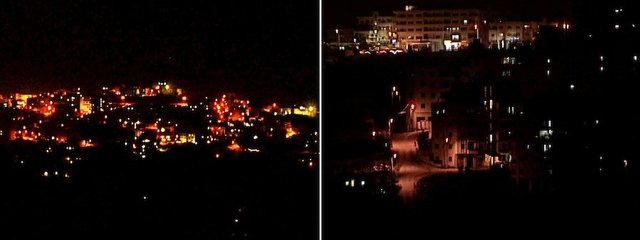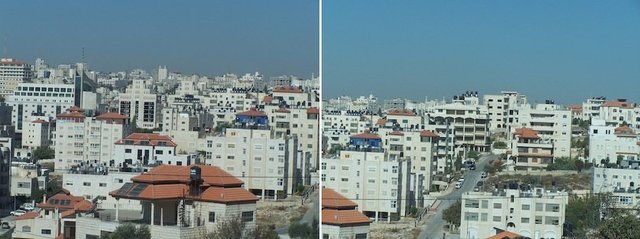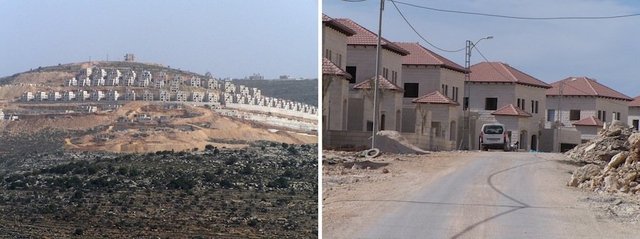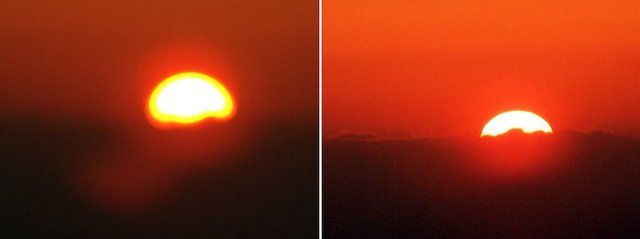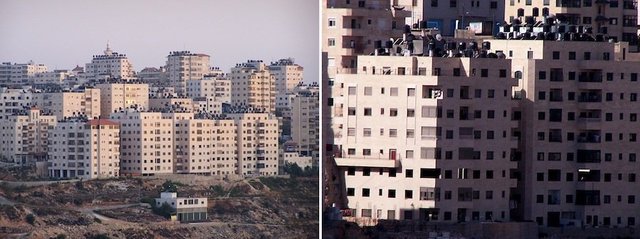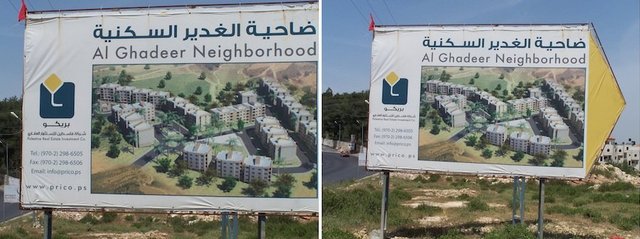Essays
Ramallah, in a Student Encounter
INTRODUCTION
In Ramallah, in July, a four-day event entitled 'Designing Civic Encounter' took place. Initiated by online platform ArtTerritories, it was envisioned as a 'series of interventions engaging in existing and potential forms of urban development and public culture' and entailed a two-day symposium encouraging discussion and debate on the subject of Ramallah's urban planning, architecture and development; a bus tour through and around Ramallah; and a day-long workshop with social architect Teddy Cruz.
Ramallah's architectural landscape has changed dramatically since the signing of the Oslo Accords in 1993, in part due to a building boom bolstered by foreign investment. In this text for Ibraaz, Yazid Anani, from the Department of Architecture at Birzeit University, corrals the thoughts of some of his students on the many themes that emerged from 'Designing Civic Encounter': their dissatisfaction with Ramallah's neoliberal urban development, which is creating a series of gated and atomized communities; the investment in 'starchitecture' in the Gulf States; and other spatial issues relating to the present-day geography of the Palestinian territories.
RAMALLAH, IN A STUDENT ENCOUNTER
A group of six third-year students from the Department of Architecture at Birzeit University dropped by for a visit. I opened the door of my apartment and welcomed them in. Some of them seemed rather shy of me, their teacher. Hiba, Ahmad, Bissan, Mohammad, Fayeq and Diala went straight to the balcony, which occupies the heart of my apartment, while I prepared plum crumble in the kitchen.
I have spent an astonishing spring semester with these students, experimenting on the role of architecture in academia and its utilization for creating critical knowledge on the current spatial transformation of Ramallah. I also worked with them in discussion with Decolonizing Architecture, an art and architecture collective and a residency programme based in Beit Sahour, Palestine, on re-imagining the abandoned edifice of the Palestinian Parliament in Abu Dis, a village on the eastern outskirts of Jerusalem. This meeting was also an ideal opportunity not only to discuss their participation in 'Designing Civic Encounter' but also to talk about the details of an exhibition we are planning, called Re-Imagining the Palestinian Parliament Building, based on their studio work in my design course. The exhibit will be located at the Khalil Sakakini Cultural Centre in November this year.
Mohammad, a very curious student from Jenin, initiated the discussion by giving his first impressions of the event.
'The feeling I got when I first arrived was surprise at the profusion of foreigners who were interested in the subject of the symposium', he began.
'It shocked me instantly, the fact that we as Palestinians, whether academics, architects, artists or intellectuals, were not interested in the subject of the symposium. The only locals who attended the sessions were the main presenters, some friends of the organizers and us! I would assume that either we as Palestinians are simply interested in pure politics and trivialize anything that has no direct relationship to the Palestinian-Israeli conflict, or it could be part of the ongoing disease we suffer from nowadays, where people think they know everything and therefore would decline attending such events!'
Ahmad, a very sharp student, seemed to be impatiently drifting away from Mohammad's prologue. Ahmad's parents live in Abu Dhabi but he was sent back to the West Bank to study architecture. He is known for his persistent dissatisfaction with the ongoing urban development in Ramallah. Part of his family still lives in Nablus but I guess he is more content living alone in Birzeit, away from the suffocating conservatism of Nablus' families and the complex social structure of the city. He took the mantle from Mohammad.
'We were basically discussing Ramallah in ArtTerritories' symposium, and the transformation of space in the last decade, thinking about spatial change as a reflection of Palestinian political doctrine, which is consciously adopting neoliberal policies as a key to peace to prove to the world that Palestinians are capable of reigning their own state', Ahmad began.
'However, succumbing to neoliberalism to enable the Palestinian Authority to build the infrastructure of the future state has seemingly created unforeseen consequences for the social structure, spatial configuration, and the imagination of the future, in addition to other issues such as the popular resistance to the ongoing Israeli occupation! My question is: why has Ramallah been selected as the target of our investigation?'
At that point Hiba, a dancer at Wishah Popular Dance Troupe and a strong, confident personality who attended my design course last semester on the 'Re-Imagination of the Palestinian Parliament Building', decided to respond to Ahmad's question.
'I don't know Ramallah that well', she said. 'I was born in Algiers and l lived there for most of my childhood. I still recall, from time to time, some images and incidents from my time there. My family also moved to Amman, as my father was sent there after Algiers, then to Bethlehem and then to Beitin and finally my parents decided to settle in Ramallah. I have lived long enough in Ramallah to witness its transformation into a bubble isolated from the rest of the local geography. What has become of Ramallah is clearer to me now after taking the bus tour on the first day of 'Designing Civic Encounter'. I was totally shocked by the urban transformation of the landscape around Ramallah. The city is surrounded by new housing projects whose visual and architectural language perplexed me. I actually asked a guy sitting beside me on the bus tour if the Diplomats Housing Project [a new housing project under construction for Palestinian diplomats and their families] was a new Israeli settlement! It is very painful to think that we Palestinians, from all nations, do not question our visual cultural production, especially at this stage when we have the possibility of creating things differently from scratch, rather than copying images of American suburbia, the Gulf housing, Amman or even the Israeli settlements. What is really going on?'
Hiba's voice as she delivered her speech was full of passion and anger, though she seemed to calm down as she sipped her orange juice.
'Going back to Ahmad's question: why Ramallah as a study case for the symposium of ArtTerritories?' Bissan said suddenly, hijacking the conversation.
Bissan is an attractive young woman from Ramallah. Her family is from the village of Sarris, one of the 418 Palestinian villages destroyed in 1948, which used to be located in the vicinity of Jerusalem on the historic road to Jaffa. The name of one of her uncles' bookshops in Ramallah is 'Sarrisi' - meaning, in Arabic, 'the person who originates from the village of Sarris' - in commemoration of the family's destroyed home village. Her father is the civil engineer who built my apartment building, which is located in one of the relatively new suburbs of Ramallah known as al-Tireh.
'I think we also have to look at other factors such as Ramallah becoming the de facto capital replacing Jerusalem and stripping it of its political, historical and institutional significance', Bissan said.
'Arafat introduced Ramallah as a surrogate capital when he was besieged in 2002, leaving Jerusalem empty and hollow and reducing it to visual cultural representations such as the Dome of the Rock, the historic city walls and the church of the Holy Sepulchre. Our generation is banned from entering the city and we identify Jerusalem only through these abstract symbolic visual items. We don't know anything about the rich social history of the city and its vivid cultural production. There is an alarming disconnection from our geography, especially for those trapped in the bubble of Ramallah with no reason to leave it or even know about any other place in Palestine,' she finished.
I felt goose-bumps forming on the back of my neck. I was very proud of the way my students were questioning architecture from a socio-political standpoint and appraising society through its architectural and spatial production. It is quite difficult for architecture students to take such a route - not least because the Department of Architecture is part of the Engineering Faculty, where the discipline of architecture is seen as pure applied mathematics and physics, regulated through building codes and represented via technical drawing. I don't believe any more in the unilateralist common trajectory of architectural education as a utilitarian discipline with practical and technical ends. It is necessary to think of architecture as critical knowledge and as a lens through which to investigate societies and read the conditions of their spatial production.
'It's the shrinking geography and shrinking minds effect', I said, in response to Bissan's question. 'Do you remember my elaboration on this issue in the symposium when I presented the example of Adania Shibli's research?'
Ahmad shook his head and explained that he hadn't attended that part of the symposium. So, I continued: 'Adania Shibli is a notorious young Palestinian writer who investigates the relationship between the continuous shrinking geography of Palestinians and the immobility of the characters in her novels. A character in one of her novels stayed in bed for 45 pages, which prompted a curiosity about the relationship between Palestinian literature and geography. She researched Khalil Sakakini, who examines mobility in the Ottoman Empire in his writings, and who was inspired by the Empire's rich cultural diversities and characters. He wrote about a whole journey he made from Jerusalem to Damascus in only two pages, while Adania Shibli was still struggling to move her character from bed after 45 pages. She has also examined writers such as Emile Habibi, Sahar Khalifeh and other young contemporary writers, to find out if that shrinking geography affects the produced knowledge in that space and influences the type of knowledge exchanged within and between the confined.'
Fayeq, one of the more argumentative students in the class, seemed preoccupied by heavy thoughts as he listened to this. His mother is a well-known architect; she was my mentor in my bachelor studies. Fayeq's particularity as a student derives from the fact that he plays the violin, too. He studies music, in tandem with his architectural education, at the Edward Said National Conservatory of Music, which allows him to travel the world to perform with his violin. His travel and passion for music has allowed him to open his eyes to differences and become perceptive and sensitive to possibilities in his personal environment. Fayeq said:
'I can totally relate to Adania's research, however I see another important dimension that I want to highlight now. Since the Israeli closure policy of 2002, we have been bounded and besieged in our own cities, perplexed and confused, trying to cut all of our affiliations with other cities and learning to live self-sufficiently. This has created what you taught us last semester, Seligman's 'learned helplessness'! We became like lab mice, trapped in our cities, confused by the inconsistency of form, location, temporality and permeability of the seizure structures. Even after the easing of check-points in recent years, we are left like mice slowly dying from hunger in their cages; helpless, frustrated and confused by the irrational and random mechanical barricades that keep us stuck in this maze. I have elderly relatives who refuse to leave Ramallah to visit family and friends in other cities in the West Bank. Even when they realize that there are no check-points, they decline to get across out of helplessness. I guess we're all suffering somehow from this collective psychological syndrome'.
I remembered, at that moment, how Vera Tamari and I had found it very difficult to convince local artists from Ramallah to apply for the open call of the 3rd edition of Cities Exhibition this year, which takes Nablus as a site for investigation. Many artists complained that Nablus is too far and they would have preferred to stay in Ramallah rather than explore the rich social history and diverse culture of another Palestinian city. It struck me then that the policies of fragmentation indoctrinated by the Israeli occupation have gone beyond the fragmentation of nation, Fatah and Hamas, Gaza and West Bank, exile and 1948; it has transformed our cities into gated communities completely disconnected from one another.
It was then I noticed Ahmad's serious frown. He sucked on his cigarette, looked at me and said:
'Ramallah has always been known as a summer resort. People from the Gulf would visit the city in the 1940s. What I want to say is that the way western media exoticizes the city's night-life, cultural scene and life of the upper middle class is nothing new. The Grand Hotel, which was shut down in the 1980s and is now totally forgotten by the influx of people now settled in the city - whether returnees, foreigners, refugees or migrants - was once a leisure and cultural space in the city, hosting Italian concerts and notorious cultural figures from Egypt, Lebanon and Europe. There were several cinemas in Ramallah including an outdoor one, which families, young people and lovers would dress up for and attend religiously. That was before the reinvention of Ramallah after the Palestinian Authority took control. The whole history of the place was forgotten and then re-established from scratch. And that is exactly what is happening now in the city! There is a conscious or possibly even unconscious desire to plan a new Ramallah on the ruins of its history, along with a tendency towards erasing its social history and architectural heritage and covering it in a new dressing. It is as if Ramallah were only invented after the Oslo Accords. This is also what is happening in other Palestinian cities. This neoliberalism of the current Palestinian Authority cabinet has changed our values. I think maybe we should surrender and all decide to leave the city so the investors can freely play their LEGO game.'
Diala, who up till then had been silent, decided to join in the argument. She is from Bethlehem; her parents made their own grand tour, moving from Germany, to Libya, Iraq and then back to Palestine, where she was born and raised. She also worked together with Fayeq last semester on the project 'Reimagining the Palestinian Parliament Building'. They came up with the idea to divide the existing building into a 3D grid and then flip all the parts inside out so that the interior replaces exterior and the skeleton replaces the skin.
'What I know is that less than one per cent of the original Ramallah families still live in the city. Most of them left to go to the United States during the last century', she began. 'Some settled there as early as 1916, working in grocery and other businesses. Yet there remains this sense of insecurity among Ramallah's 99 per cent of 'unoriginal' inhabitants, centred around the question of who is an original and who is not. Modern Ramallah is made and remade by the perpetual influx of the 'unoriginals', whether refugees, migrants or returnees. The unplanned boom of the late 1990s following the arrival of the Palestinian Authority caused the first mutation to the city. The building spree's jingle was seemingly: 'Everyone can build anything, everywhere!' Amman has become a raw model to most of the architects I know. It might be that our limited exposure in Palestine means that we have only Amman as the garden from which to draw inspiration. The Gulf has also become the dream of many students and graduates. With Zaha Hadid's edifices filling the place, which I personally see as sculptured vases, most of the students at the department want to create similar structures in Ramallah to complete the anomaly. I think we want the grandeur that these monuments represent and that we don't currently have, and the freedom of expression that they would suggest. Yet we are still entangled in complex, conflicting identities that we're still trying to comprehend and evade at the same time, because it reminds us of defeat and failure. Maybe we love Zaha's vases because we want to escape the past and its visual cultural representation and familiarity. We want the new and the unfamiliar'.
'I hate the idea that Amman is raw model for us!' Mohammad interjected. 'There is something about Amman that makes me uneasy. I share this feeling with almost every Palestinian I know that either lived for a short term in Amman or passed through it to get to the outside world, Queen Alia Airport being the only gateway through which Palestinians are able to travel. And people have always wondered why we hate Amman!'
A long discussion took place. I heard nearly the same thing from all of them, relating to the hassle involved in crossing three consecutive authorities - Palestinian Authority, State of Israel and the Kingdom of Jordan - located along a one kilometre border, where people must succumb three times to almost identical rituals of passport control, security check, luggage X-ray check, metal detectors, interrogations and customs, just to leave the country. If one is lucky, and the border not horribly congested, this whole process can take four hours. People often wonder why these three border points can't join forces, instead of engaging in this show of power - especially when most people are already aware of the intelligence sharing that goes on between the three, in addition to other known and unknown treaties. People reach Amman totally drained and frustrated before they take their flights elsewhere. Amman becomes a subliminal reminder of the hell they'll once again have to suffer in order to get back home. I personally don't hate Amman but I have always felt despair when flying back home from Europe and seeing Ramallah from the airplane window, only to have to then land at Queen Alia Airport, have a layover in Amman and wait until the next morning for the border to open in order to get back home.
We spent another couple of hours discussing other issues, such as the Arab Spring, resistance, the future and neo-colonialism, all of which branched out of the topics and incidents that came up in the symposium.
The students left me with a feeling of urgency for a new Palestinian political leadership that uses the potential and energy of younger generations and that listens to the way they see their present and dream of their future. Building a Palestinian state is not just about building an economic and security infrastructure; it requires investing in the minds of young Palestinians, who will one day build a state based on an intelligent and critical political economy.

